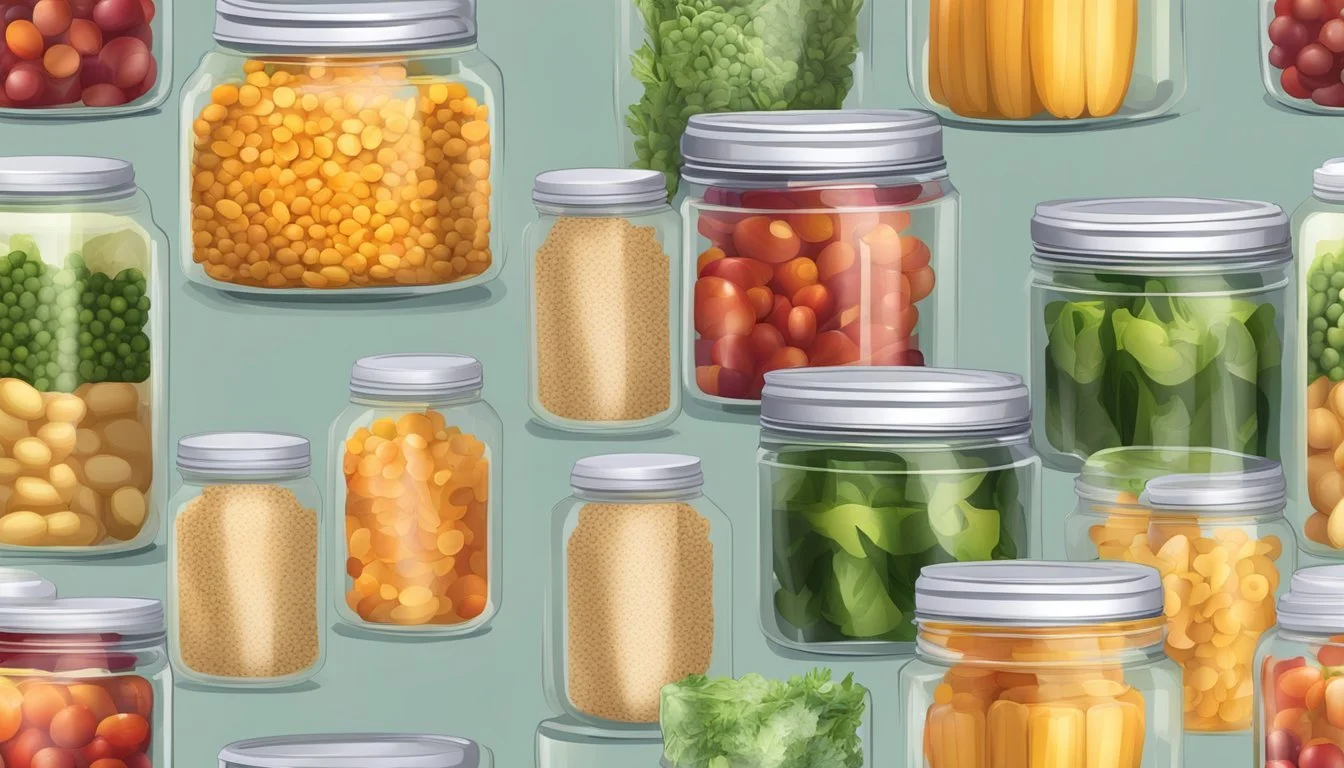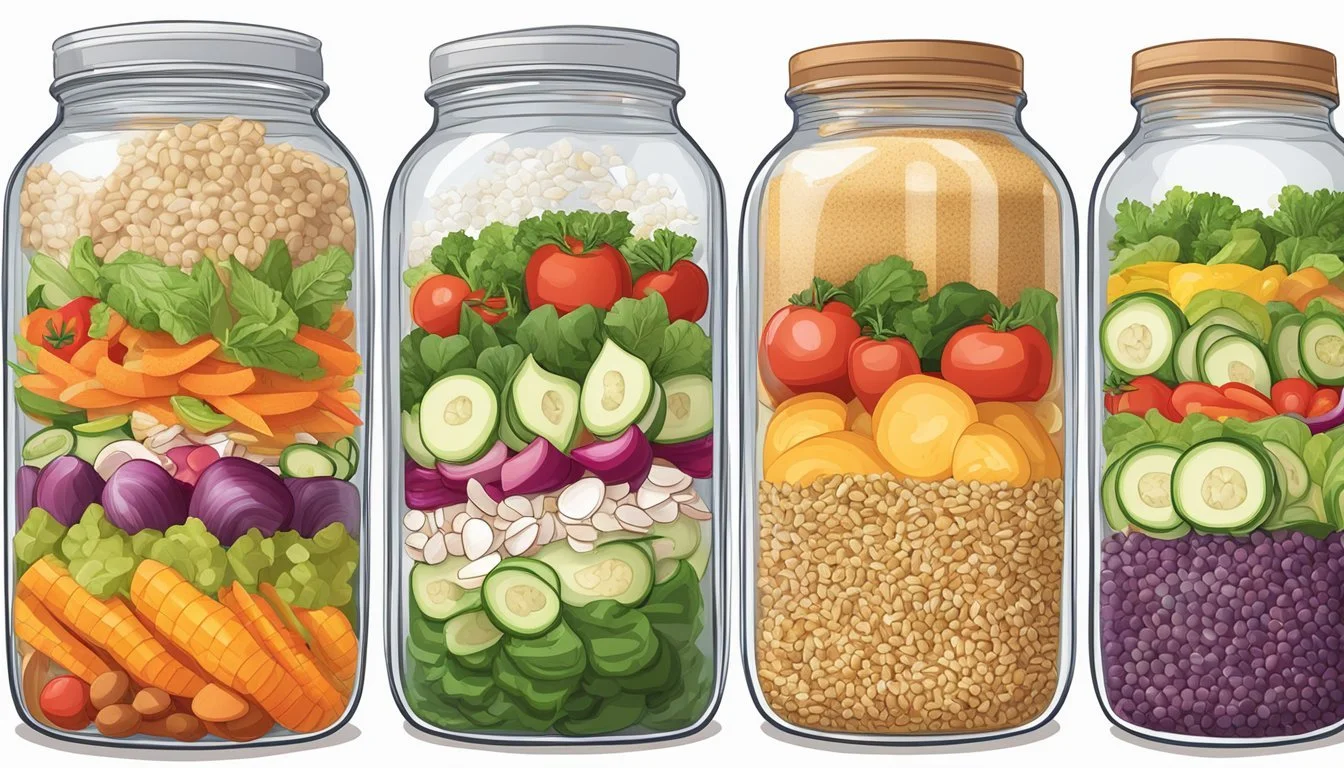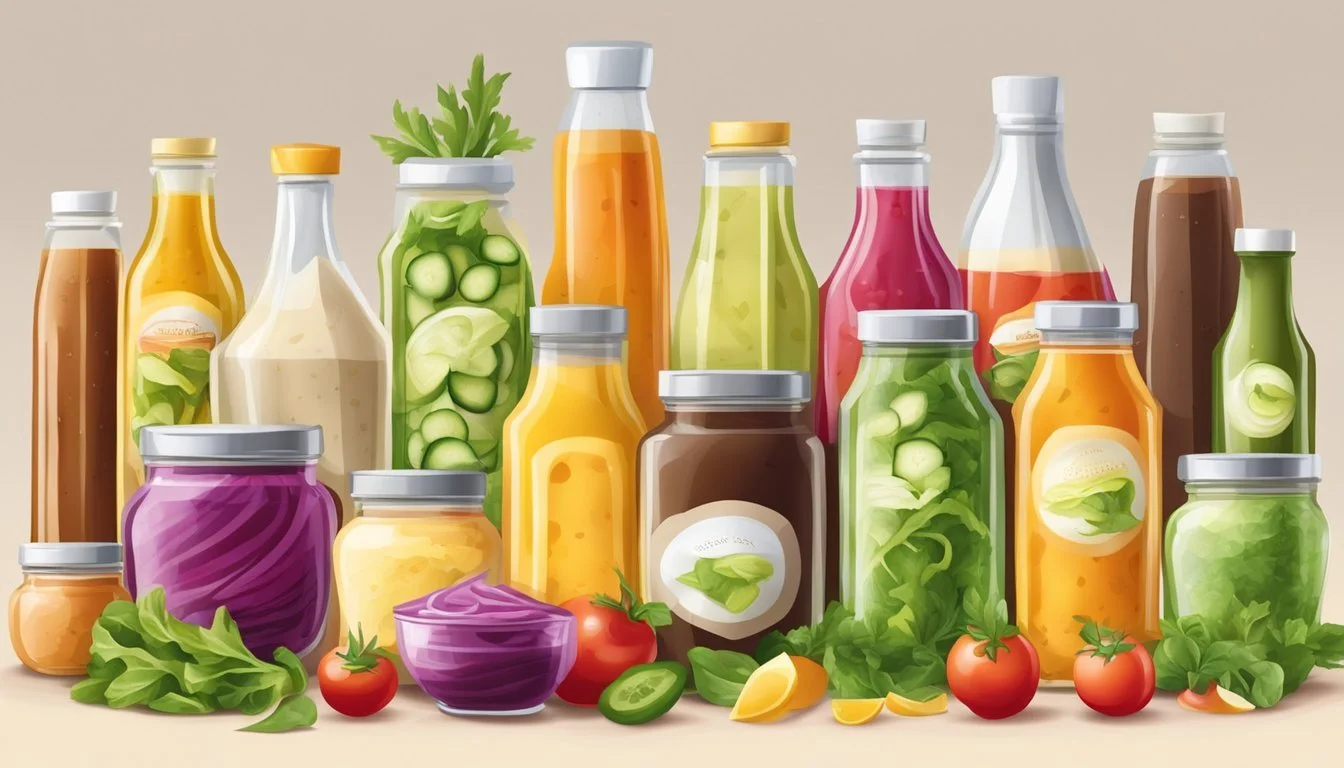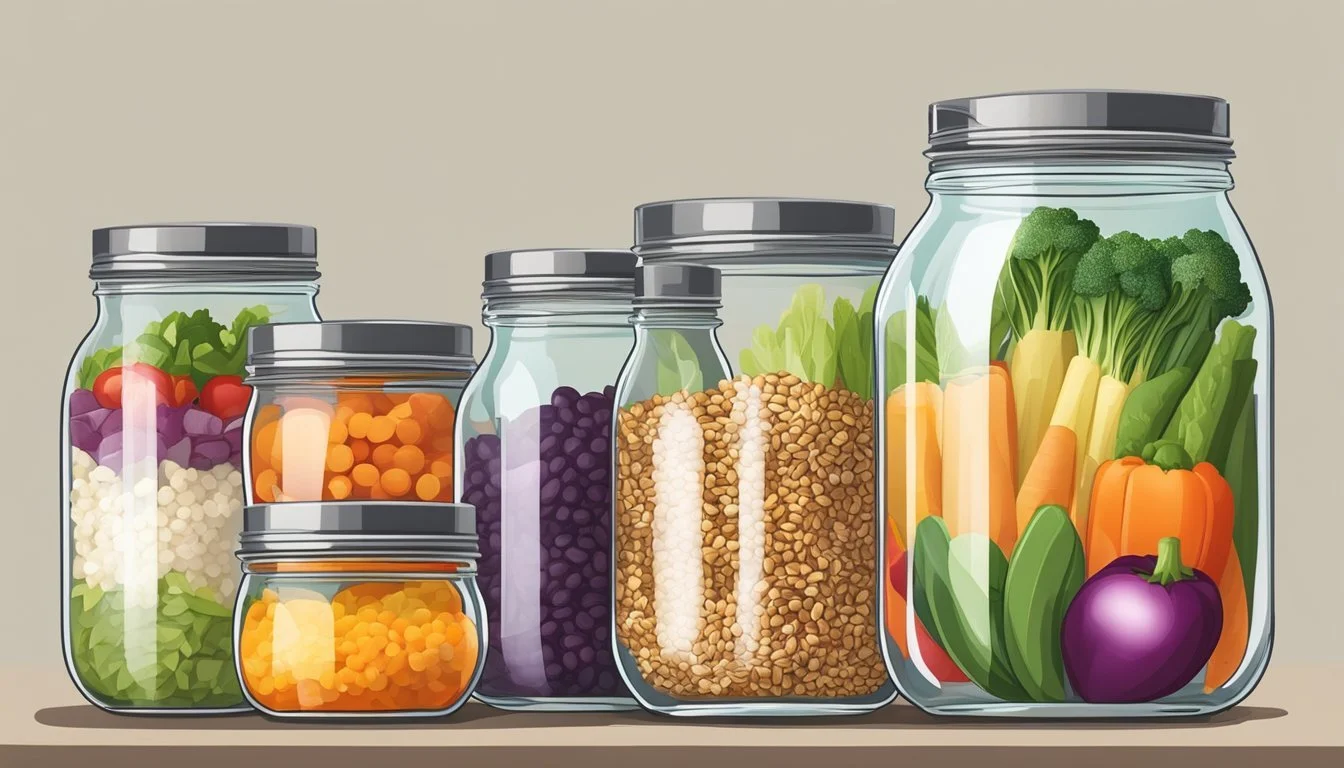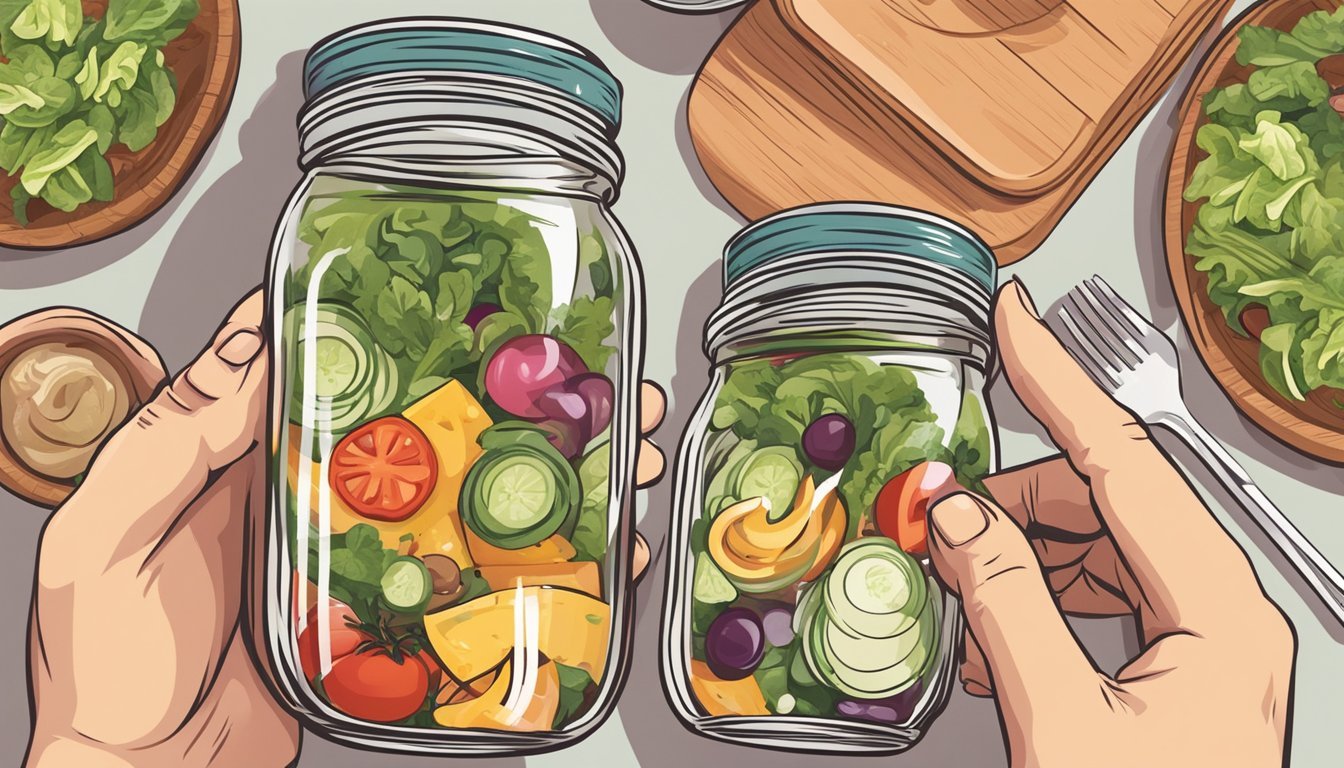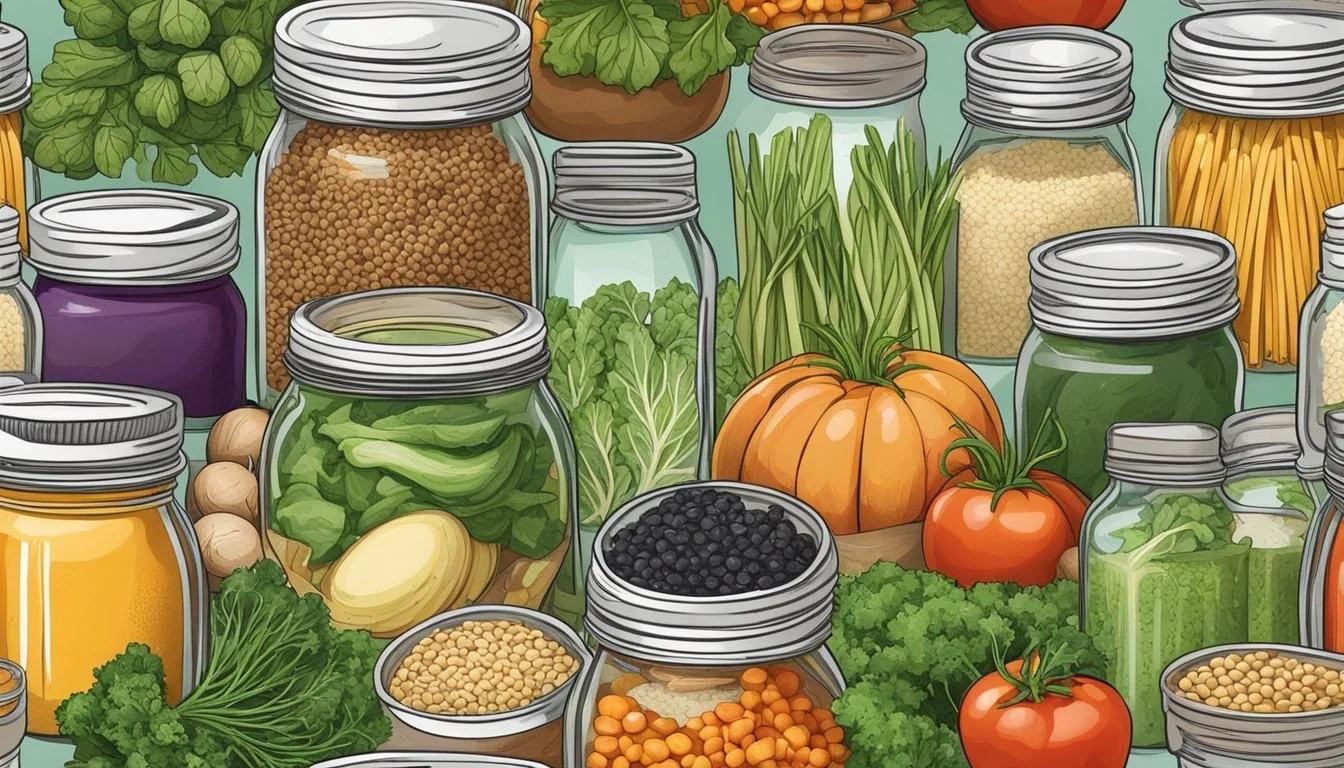The Jar Salad Shake-Up
Mastering Layered Flavors On-the-Go
Jar salads (What wine goes well with salads?) are a vibrant and ingenious way to pack a nutritious meal into a single container. This culinary trend turns the concept of salad on its head by layering ingredients in a mason jar, preserving their freshness and creating a visually appealing meal that's as practical as it is tasty. The jar salad's appeal lies in its versatility and convenience, offering a portable solution for healthy eating without sacrificing flavor or texture.
The process of building a jar salad involves strategic layering to maintain ingredient integrity and ensure an even distribution of flavors upon shaking. Beginning with dressing at the bottom, layers ascend from the heaviest and most moisture-resistant items to the lightest, leaving the salad greens until last. This method not only prevents sogginess but also allows for a quick mix by shaking the jar when it's time to eat, melding the components into a coherent dish.
Their compact nature makes jar salads particularly popular among meal preppers, office workers, and health enthusiasts. Whether looking for a hearty lunch or a light, energizing meal, these salads are endlessly customizable, allowing for a variety of ingredients including grains, proteins, vegetables, and nuts. Crafting the perfect jar salad is a delicate balance of texture, flavor, and nutrition, resulting in a meal that's as delicious as it is functional.
Essentials of Jar Salad Construction
Constructing the perfect jar salad is an art that combines practicality with creativity. The essentials involve picking an appropriate jar, layering the ingredients thoughtfully, and selecting the best quality components to ensure a fresh and flavorful meal.
Choosing the Right Jar
When it comes to jar salads, size and seal are paramount. A quart-sized mason jar is often the best choice, providing ample space for a full meal while still fitting conveniently in a lunch bag. The jar should come with a tight-sealing lid to keep ingredients fresh and prevent leaks. Glass is preferred for its non-reactive nature and ability to showcase the salad's colorful layers.
The Art of Layering
The strategic placement of ingredients is critical to maintain texture and flavor. The layering should proceed as follows:
Dressings: At the base, 2-4 tablespoons to prevent sogginess.
Hearty vegetables or fruits: Such as cherry tomatoes or cucumbers, which can withstand the moisture without wilting.
Proteins or grains: Items like cooked chicken, beans, or quinoa.
Softer vegetables or fruits: Such as avocados or diced apples.
Cheese and nuts: For a burst of flavor and texture.
Greens: On top to stay crisp, acting as a barrier to moisture.
Selecting Quality Ingredients
Choosing fresh and quality ingredients ensures the salad remains tantalizingly flavorful:
Vegetables: Opt for a variety, from leafy greens to crunchy carrots, ensuring a wide array of nutrients.
Proteins: Include lean proteins like chicken, tofu, or boiled eggs to sustain energy levels.
Fruits: Introduce sweetness and vibrancy with fruits such as berries or orange segments.
Grains: Consider whole grains like farro or brown rice for added fiber.
Nuts and seeds: Toasted almonds or pumpkin seeds add crunch and healthy fats.
Cheese: A small amount of a strong cheese, like feta, enhances the overall taste.
Dressings: Choose or make a dressing that will complement the ingredients, considering the balance of acidity and oil.
By prioritizing these essentials, one can easily construct a jar salad that's as delightful to eat as it is to look at.
Nutritional Building Blocks
Mason jar salads present a unique opportunity to layer nutrition as creatively as they layer flavors. Each stratum can be tailored to meet dietary needs with a balance of proteins, fruits and vegetables, and healthy fats.
Protein Selection
Proteins serve as the building blocks of the body, aiding in muscle repair and growth. When selecting proteins for mason jar salads, options abound.
Beans: A great source of plant-based protein; chickpeas or black beans are popular choices.
Seeds: Including chia, hemp, or sunflower seeds adds a protein boost and a crunchy texture.
Nuts: Almonds, walnuts, and pecans not only increase the protein content but also contribute essential fatty acids.
Vegetable and Fruit Varieties
Vegetables and fruits are essential for providing vital nutrients and fiber. They add color, texture, and flavor to the salad.
Veggies: Kale, spinach, and arugula are nutrition-packed greens, while bell peppers (What wine goes well with bell peppers?) and cucumbers offer crunch and hydration.
Fruit: Sliced strawberries, apples, or grapes can add a natural sweetness and additional vitamins.
Incorporating a rainbow of produce ensures a broad spectrum of nutritional benefits.
Adding Healthy Fats
Healthy fats are crucial for nutrient absorption and maintaining cellular health. They also add a satiating element to the salad.
Avocado: A source of monounsaturated fats, it adds creaminess when included in a salad.
Olive Oil: Integral to dressings, it pairs well with vinegar or lemon juice to start the layering process.
Nuts and Seeds: As mentioned for protein, they also contribute healthy fats and omega-3 fatty acids.
Balancing these components can transform a simple mason jar salad into a nutrient-dense meal that is as satisfying as it is healthy.
Mastering Salad Dressings and Sauces
The foundation of any tantalizing salad is its dressing, which can elevate humble ingredients to new heights of flavor. Mastering homemade dressings and understanding classic recipes allows for both a healthier choice and a customized taste experience.
Homemade versus Store-Bought
Homemade dressings offer several advantages over their store-bought counterparts. They lack the preservatives and additives often found in commercial dressings, leading to fresher, more natural flavors. The ability to customize ingredients to personal preferences is another benefit. A simple vinaigrette, for example, can be made with quality olive oil, vinegar, salt, and pepper, and then personalized with other seasonings.
Conversely, store-bought dressings provide convenience and consistency. They are instantly ready for use and offer a wide range of flavors that might be complex to replicate at home. However, they often contain higher levels of sodium, sugar, and other processed ingredients, which might not suit all dietary preferences.
Homemade Dressings Store-Bought Dressings Pros Fresh ingredients Convenient Customizable Consistent flavor No preservatives Wide variety Cons Takes time to make May contain additives Shorter shelf life Often less healthy
Classic Dressing Recipes
When one is starting to explore the world of salad dressings, mastering a few classic recipes is key. These foundational formulas act as a canvas for further experimentation.
Basic Vinaigrette: A classic French dressing that is simple yet elegant, made with 3 parts olive oil to 1 part vinegar, seasoned with salt and pepper, and optionally enhanced with Dijon mustard or minced garlic for added complexity.
Creamy Caesar: This rich dressing is traditionally prepared with an emulsion of anchovies, (What wine goes well with anchovies?) egg yolk, crushed garlic, Dijon mustard, olive oil, lemon juice, and seasoned with pepper and sometimes Worcestershire sauce.
Italian Dressing: An infusion of olive oil, vinegar, chopped bell peppers, onions, usually a sweetener like honey or sugar, and a blend of herbs such as oregano, basil, and rosemary, finished with salt and pepper to taste.
It is essential for one to remember that the ratio of oil to acid (vinegar or citrus juice) can greatly affect the final taste and consistency of a dressing. The typical ratio is 3:1, oil to vinegar, but preferences for a more tangy flavor might lead to adjustments. Homemade dressings can be stored in a sealed container or jar in the refrigerator for freshness and are best when shaken well before serving.
The Convenience of Meal Prepping
Meal prepping unlocks the potential for both a time-efficient and health-conscious lifestyle. By embracing make-ahead meals like mason jar salads, individuals can enjoy convenient, fresh dining throughout the week.
Prepping for the Week
The appeal of meal prep lies in its methodical approach. Mason jar salads serve as the ideal solution for a week's worth of lunches or dinners. The process is simple: one dedicates a portion of time, typically on a weekend day, to assemble various ingredients into mason jars. Here is a step-by-step guide to prepping these nutritious meals:
Layering: Start with a dressing base, followed by harder vegetables that can withstand moisture.
Protein Addition: Add a protein source such as chicken, chickpeas, or lentils to the jar.
Sealing in Freshness: Top the jar with leafy greens and seal to maintain freshness.
Through this organization, one ensures a week filled with balanced meals. They can simply shake up their mason jar when ready to eat, mixing all components to create a flavorful experience without the need for a bowl.
Storing for Freshness
Storing mason jar salads correctly is essential to maintain freshness and extend their shelf life. Keeping them in the fridge, the salads can stay fresh for up to five days, depending on the ingredients used. The mason jar's airtight seal is crucial to preventing the ingress of air, which can lead to spoilage. Consider the following for optimal freshness:
Temperature: Store jars in the coolest part of the fridge, usually at the back, away from the door.
Order of Ingredients: Place moisture-wicking items like grains or beans at the bottom, protecting delicate leafy greens at the top.
By following these storage steps, individuals ensure their meals remain as fresh as the day they were prepared, providing convenience without sacrificing quality.
Creative Combinations and Flavors
Mason jar salads are a vibrant canvas for blending a diverse range of ingredients, allowing for a myriad of flavor combinations that traverse different culinary landscapes. By layering ingredients thoughtfully, one can create salads that are not just visually appealing, but also tantalizingly flavorful and diverse in texture.
Cultural Fusions
Mexican-Italian Blend: An exciting cultural fusion can be found in a salad that marries the bold flavors of Mexican cuisine with the classic elements of Italian fare. Begin with a cilantro-lime dressing at the bottom, followed by layers of black beans, charred corn, finely diced tomatoes, and a hefty sprinkle of cotija cheese. A layer of al dente pasta, such as orzo, can marry the two cuisines together. Top it off with shredded romaine lettuce and a handful of toasted pine nuts.
Mediterranean-Thai Medley: Combining Mediterranean and Thai flavors creates an aromatic and nutrient-rich salad. A base of sesame ginger dressing paves the way for layers that include chickpeas, crunchy bell peppers, kalamata olives, and cucumbers. Add in a layer of quinoa to absorb the dressing and mingling flavors. Finish with a layer of spinach and a sprinkle of feta cheese. For a Thai twist, garnish with basil and crushed peanuts before sealing the jar.
Themed Salad Ideas
Thai Chopped Chicken Salad: A Thai chopped chicken salad encapsulated in a mason jar starts with a bottom layer of a sweet and spicy peanut dressing. Follow with vibrant vegetables such as shredded carrot, sliced red pepper, and snappy snow peas. Continue with chopped grilled chicken and a modest layer of soba noodles or rice, building up to a leafy layer of mixed greens. Cilantro leaves and a sprinkle of sesame seeds complete the experience.
Easy BBQ Chicken Salad: A recipe for an easy BBQ chicken salad in a jar involves a foundational layer of zesty BBQ dressing. Layer in corn kernels and black beans, then add a mix of cherry tomatoes and diced red onions. Add a hearty portion of shredded BBQ chicken and a sprinkle of cheddar cheese, followed by a final layer of romaine lettuce. Crispy onion strings or a handful of tortilla strips on top can add a satisfying crunch.
Chicken Fajita Salad: The trend of mason jar salads meets classic Mexican flavors with a chicken fajita salad variant. Begin with a savory fajita-inspired dressing, followed by layers of sautéed bell peppers and onions, succulent slices of fajita chicken, and a mix of black beans and corn. Complete the jar with a hefty layer of mixed greens, ensuring the lettuce stays crisp and fresh. A sprinkle of cilantro and shredded cheese makes it customizable at the moment of serving.
Unique Tips and Tricks
When creating mason jar salads, the success largely rests on layering strategy and ingredient selection. These tips and tricks ensure flavors remain distinct and textures stay crisp, offering a satisfying meal without the need for a bowl.
Using Leftovers
Repurposing leftovers is an art when it comes to mason jar salads. They introduce unexpected layers while reducing food waste. Key considerations when using leftovers are:
Moisture content: Leftover grains or proteins with lower moisture content should be placed above the dressing layer to maintain texture.
Density: Heavier items like roasted vegetables can form a barrier over wetter ingredients, aiding in the separation of layers.
Example of using leftovers effectively:
Dressing (Bottom)
Roasted sweet potatoes (heavy, lower moisture)
Leftover chicken or tofu (dense protein)
Grains like quinoa or rice (dry, absorbent)
Greens or herbs (Top)
The Secret to Perfect Textures
Maintaining perfect textures is crucial and can be mastered with proper layering techniques:
Hard Vegetables: Position hard vegetables like carrots or cucumbers immediately above the dressing. They are resilient and prevent sogginess.
Equipment: A wide mouth mason jar, particularly pint jars for individual servings, is ideal. They facilitate layering and mixing without spilling.
Use this table as a guide for perfect textures and layering:
Layer (Bottom to Top) Ingredient Type Purpose and Benefit 1 Dressing Separates from other ingredients to avoid sogginess 2 Hard vegetables Acts as a barrier; stays crisp 3 Beans, grains, or pasta Absorbs flavors, adds substance 4 Protein Keeps dry until the jar is shaken 5 Nuts, seeds, cheese Adds crunch and flavor; maintains form 6 Greens, herbs Placed at the top to stay fresh and unbruised
By adhering to these principles, one ensures their mason jar salad remains an appealing and fresh option for meals on the go or at home.
Sustainable and Cost-Effective Shopping
When crafting a mason jar salad, a shopper’s approach to selecting ingredients can bolster both wallet and environmental well-being. Strategic choices in purchasing can lead to cost savings and reduced waste.
Buying In Bulk
Consumers can save a considerable amount of money by opting for bulk purchases. Dry goods such as quinoa, nuts, and seeds are perfect for layering in jar salads and often come with a lower price tag when bought in large quantities. Additionally, buying in larger volumes reduces packaging waste, aligning with eco-friendly goals.
Money Saving Tip: Comparing cost per unit between bulk and pre-packaged items can reveal significant savings.
Nutrient Optimization: Selecting a variety of bulk-purchased nuts and seeds enriches the salad with healthy fats and proteins.
Seasonal Ingredient Selection
Choosing seasonal ingredients for mason jar salads ensures peak flavor and nutrition while often costing less than out-of-season produce. Fresh, leafy greens like spinach, romaine, or Little Leaf Farms' varieties are more affordable when they're in season and local. They serve as a crisp, nutrient-dense base for the jar salad.
Summer Harvest: Include ripe tomatoes, cucumbers, or bell peppers which are plentiful and lower in cost during summer months.
Winter Finds: Opt for robust greens like kale or chard, which thrive in cooler weather and can withstand the dressing when layered at the bottom of the jar.
By adhering to these strategies, individuals can relish in the freshness of home-prepared salads that are as kind to their health and taste buds as they are to their budget and the planet.
Elevating Your Routine
Transforming your daily meal routine with jar salads offers a versatile and convenient way to pack in nutrients while enjoying a variety of flavors. By layering ingredients strategically, one can craft a satisfying meal that is both portable and delicious.
Incorporating Superfoods
In the realm of superfoods, seeds such as sunflower seeds provide a crunchy texture and are a powerhouse of vitamins and minerals. Adding a tablespoon of sunflower seeds to a salad introduces healthy fats, Vitamin E, and magnesium. For striking flavors and nutritional benefits, one might also consider:
Hummus as a protein-rich layer or creamy base
Pesto for its heart-healthy fats and robust taste
Integrating superfoods not only elevates the taste but also boosts the nutritional profile of the meal.
Diet-Specific Variations
For those adhering to a vegetarian diet, ensuring that the jar salad is both fulfilling and nutritionally adequate is key. Here are tailored suggestions:
Vegetarian Ingredient Benefits Quinoa Complete plant-based protein Chickpeas Fiber and protein source Tofu High in calcium and iron
To customize salads to specific dietary preferences, substituting the base layer or protein source is effective. Mixing in vegetarian-approved toppings like hummus or pesto can also add depth to the flavor and nutritional value.
Conclusion
Salad in a jar is an innovative twist on the traditional way of serving salads. It has transformed meal prep into a convenient, stable, and appealing practice. The structure of the layered ingredients allows for the flavors to mingle without getting soggy, ensuring a crisp and delicious salad every time. With a focus on using a wide-mouthed 32 oz. jar for optimal layering and ease of mixing, individuals can prepare their healthy meals for the entire week while maintaining their freshness.
The foundational rule lies in layering dressing at the bottom with firmer vegetables that create a barrier, preventing the greens at the top from wilting. Ingredients should be packed tightly to minimize air and potential food spoilage. Not only does this method promote nutrient-dense meals, but it also provides a visually appealing way to enjoy a variety of textures and flavors.
When it's time to eat, the jar is simply shaken to distribute the dressing, ensuring an evenly coated, flavor-rich salad upon transfer to a plate or bowl. The mason jar salad is an embodiment of both convenience and health, making it highly suitable for those with a busy lifestyle yet unwilling to compromise on quality, wholesome nutrition.
In summary, the salad-in-a-jar concept brings ease and enjoyment back into healthy eating, making it a staple for anyone looking to maintain a balanced lifestyle. Its simple yet effective structure makes it practical for meal preps and on-the-go dining.


